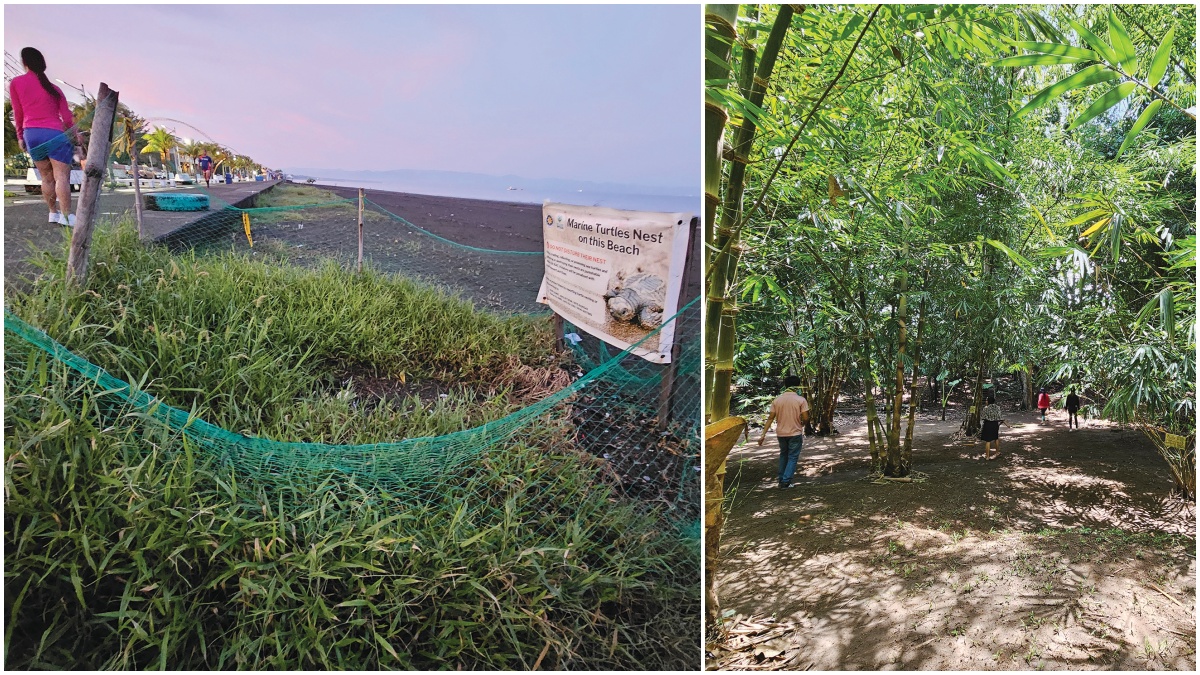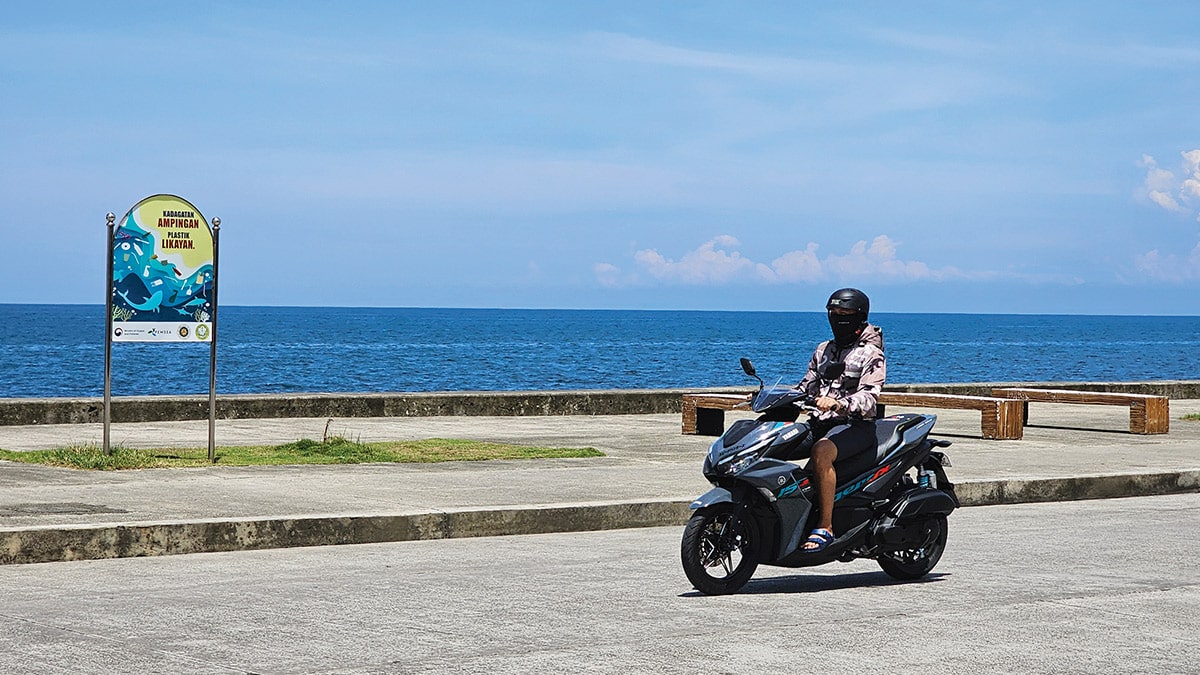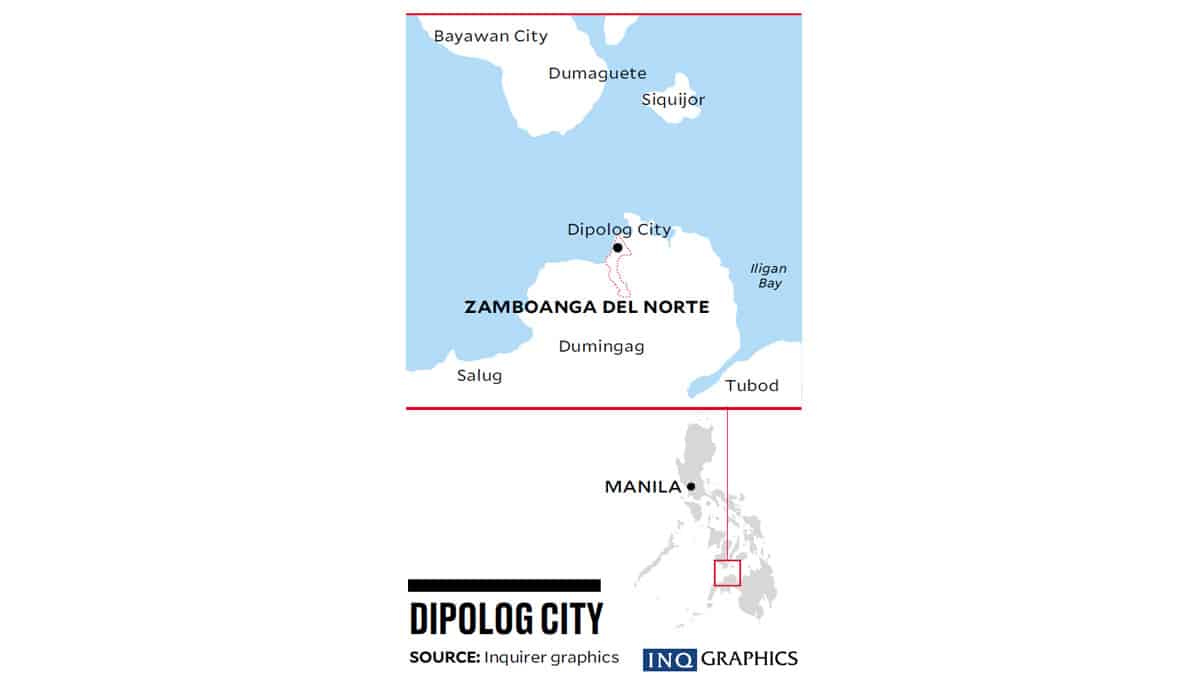In Dipolog, environment protection is top concern

NATURE IS KING A pair of fishers (top photo) stake out for a catch in a portion of Dipolog Bay where bulk fishing is allowed. Above left, a turtle nesting site along the city’s coastline is marked to avoid it from being disturbed by human activity. The local government is also taking care of a bamboo forest as it embarks on a reforestation project, especially along its riverbanks. —PHOTOS BY RYAN D. ROSAURO
DIPOLOG CITY—Even amid a drizzle, scores of people young and old, with rods in tow, take their respective places at a breakwater and in moored boats to cast a line as schools of fish swarm about in the current as the waters of Dipolog River empty into Dipolog Bay.
The “bukana” or river mouth here is the main choice for line fishers to stake out for catch.
“This area is rich with fish,” Reggie, a line fisher, explained in Bisaya, pointing to the patches of mangroves along the river and on the foreshore of Barangay Barra, a fishing community.
He recalled that several days back, a line fisher caught an 8-kilogram fish there, probably grazing on smaller ones and on the abundant sea grasses.
Since the practice of blast fishing was eliminated several years ago, the marine riches of the bukana and the bay had returned, the line fishers told the Inquirer.
Article continues after this advertisement“There is strict enforcement of fishery laws here, but that is for everybody’s good because we are able to enjoy [its effects]. If you use nets, you should venture some 100 meters from the shore,” said Reggie, adding that he knew about these rules through the public education campaigns of the local government.
Article continues after this advertisement“It is heartening to hear that our past efforts had borne fruit and are taking root, especially among those who are direct stakeholders of environmental conservation,” said lawyer Gratian Paul Tidor, acting head of the City Environment and Natural Resources Office (Cenro).
Environmental conservation and protection has been high on the local government’s agenda in the last two decades, along its “Swigapore goal” that seeks to transform the city into a sustainable and self-reliant urban community where people had easy access to social services, following in the footsteps of Switzerland and Singapore.
According to Ernie Rojo, local economic and investment promotions officer, the city pioneered the idea of a fishing ban on herring or “tamban” which goes into the production of the famous Dipolog gourmet sardines.
The ban, from December to February, ensured that the fish population is able to regenerate hence sustaining the catch levels and also the city’s sardines industry, Rojo explained.
The 1734 Murillo Velarde map of the country under Spanish possession indicated a settlement named “Diporog,” which attests to the long history of the locality.
Founded in 1834, Dipolog was reverted into a barrio of Dapitan in 1904 and reestablished as a municipality in 1913. It became a city in 1970. It has been the capital of Zamboanga del Norte province since its creation in 1952.
Transformation
Although its laidback character is still there, the changing economic and technological landscape is transforming Dipolog
At present, the third class city (average annual income of P240 million but less than P320 million) hosts 138,141 people in its 13,800-hectare land area, per the census of 2020, but its daytime population is estimated to swell to 200,000 with throngs of students attending classes in the city’s schools.
This influx of young people in a given day has driven the surge of pop-up coffee shops, especially in the city’s university belt, raising new challenges in waste management, said Tidor.
“Most of these youngsters prefer iced coffee, which requires plastic cups, as opposed to paper cups for hot coffee,” he noted.
To address this, the Cenro is exploring possible incentives to these stores for “plastic cups avoidance” measures such as reducing selling price for those who bring their tumblers. “All these are currently in the drawing board,” Tidor said.
In a given day, Dipolog generates up to 25 tons of waste. Of these, 60 percent are biodegradable, and up to 2 tons are plastics. With 80 percent of the collected waste properly segregated, further sorting of these at the city’s materials recovery facility becomes more efficient.
To avoid dumping the residual plastics into its landfill, the local government ships these to the factory of Holcim Cement in Lugait, Misamis Oriental, to feed to its waste-to-energy plant.
Tidor credits the already minimal plastic waste generated by the city to the reduction of its use in commercial establishments, mainly due to the single-use plastics ban.

AVOIDING PLASTICS A motorist passes by a signage discouraging the use of plastics in Dipolog City in order to help save the environment.
To further add to the pressure against plastics, Cenro imposed upon itself the ban on the use of styrofoam food packs during its activities with Tidor hopeful this can become a policy for the rest of local government offices.
Today, the local government hopes to build on this track record for the larger goal of helping address the further warming up of the planet.
Shift to solar power
Tidor said Mayor Darel Uy had pushed them to innovate to reduce the local government’s carbon footprint given its 250,000 kilowatt-hour monthly energy needs and help sequester carbon in the atmosphere.
This was the inspiration for the city’s shift to solar-powered streetlights, a strategy that also gained traction among the barangay governments. In the pipeline is the shift to renewable power for City Hall and the local government-owned Corazon C. Aquino Hospital.
Uy has ensured that planned facilities like the slaughterhouse and public market are designed to be operated through the use of natural ventilation and lighting.
For carbon sequestration, the local government has embarked on massive bamboo planting, especially along riverbanks and in a 2-ha upland area.
Tidor said bamboo can sequester two tons of carbon a year and matures within four to five years, meaning, it grows 80 percent faster than the average hardwood species.
The local government has partnered with the water district to develop a bamboo forest in one of its spring sources. As of 2022, the local government had planted more than 78,000 bamboo along the riverbanks and creeks, helping also prevent erosion and flooding.
Every year, the local government mobilizes youth volunteers to plant some 5,000 native trees within its 356-ha ecopark in Barangay Cogon, further boosting the carbon sequestration capacity of its natural forest that spans about 40 percent of the area. INQ

